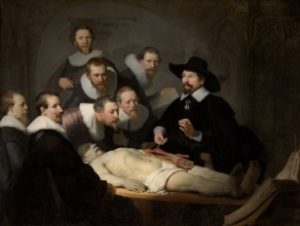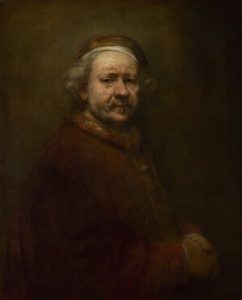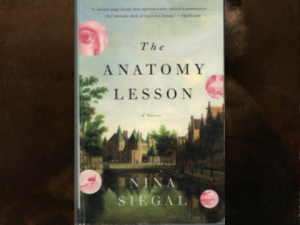The talk began with a brief resumé of how the protestant Dutch revolt against Spanish rule lead to independence and the Golden Age. The Dutch accrued enormous wealth from trade and became Europe’s storehouse for grain and timber, the staples of food, housing and shipping. Amsterdam was the hub. It was a time of great sophistication with huge interest in the arts and sciences. The expanding merchant class generated vast wealth and stoked a thriving art trade. Rembrandt was there at the right time. He was born in Leiden in 1606, the son of a prosperous malt miller and his mother belonged to a wealthy family of bakers. Although they were Calvinists, Rembrandt himself was never particularly religious. He was at the Latin school from 14 followed by Leiden University, but his passion was art and he dropped out from a classical education at 16. His first apprenticeship was 3 years with Jacob van Swanenburgh in Leiden. He then moved to Amsterdam for a year with the influential Pieter Lastman, an eminent artist who had returned from Italy having met Caravaggio and Titian.
Rembrandt was temporarily in Leiden as an independent artist but quickly followed the money to Amsterdam in 1631 and took lodgings with Hendrik Uylenburgh, an influential art dealer. His reputation grew rapidly with portrait and historical scene commissions.
He quickly made important contact with royalty and the Amsterdam elite. Within a year, he was given a pivotal “make or break” commission to paint the fourth Guild of Surgeons’ group portrait as a record of the Praelector’s (Professor’s) Annual Public Anatomy. These portraits date from 1603 and most can be found in the Museum of Amsterdam together with those of the other guilds.
Philip II had granted a privilege in 1555 to dissect an executed criminal once a year not only for the purpose of teaching and learning anatomy, but also for contemplating life and death; religious fear governed the destiny of the soul. The dynamic teaching and gestures of Dr Tulp and the other guild members contrast with the static corpse and provide the analogy. The Dutch had a huge stomach for this sort of public entertainment. Public dissections lasted about 3 days and held in January for obvious reasons.
Rembrandt was just 25 and had relatively few portraits under the belt, so no sweat. But he was brave enough to depart from the stiff formalised group portrait to create the dynamic “The Anatomy Lesson of Dr Tulp 1632”, now permanently housed in the Mauritshuis Museum in The Hague.
Detailed archival records of the Golden age are available in the Netherlands. Dr Tulp was born Claes Pietersz but changed his name to Tulp, hanging a swinging board with a painted tulip over his consulting room front door so his patients could find him easily – many were illiterate – a good move! It was the time of tulipmania.
Tulp qualified in medicine in Leiden and was the first to establish the link between lung disease and tobacco.
His staple treatment was “purging simples, in degrees from gentle to violent, upwards or downwards”. Melancholy was very fashionable at the time.
He also signed off fitness reports on the first Manhatten settlers. In 1641 his “Observationes Medicae” brought him international fame and became a standard textbook for many years. As an accomplished artist, he illustrated it himself. He was incidentally the first to record the existence of the chimpanzee!
He became Praelector of the Surgeons’ Guild in 1628, was the official city anatomist, founded the Collegium Medicum (forerunner of the Amsterdam University Medical School), elected mayor and was a central player in Amsterdam society.
The Anatomy Lesson of Dr Tulp shows him teaching the relationship between the anatomy of the flexor digitorum superficialis muscle of the forearm and its function, replicated and demonstrated by Tulp with his left hand. This muscle bends the fingers forwards (e.g. in waving).
Seven guild members and an unseen audience of up to 300, packed and stacked in steep tiers of the surrounding anatomy theatre, are being taught by Tulp, whose dominance is marked by a dynamic posture, a large brimmed hat, flat white collar and black finery, in direct contrast with the naked static white corpse. This was Aris ‘t Kint who was executed on Jan 31st 1631 as a serial thief. Prior to execution he was branded and his right hand was amputated as extra punishment.
The Anatomy Lesson of Dr Tulp was almost certainly not painted “live”. Dissection normally started with abdomen and chest, clearing the contents before the stench set in (too badly). The guild members were dressed in their best. Individual studio portraits were probably prepared before the dissection. There is no record of Rembrandt’s presence at the dissection and he left no preliminary drawings, although he undoubtedly had attended others, if not this particular one. The dissected left arm was probably studio painted, either Aris ‘t Kint’s own after the dissection or some other corpse’s arm. Rembrandt might just have copied from an anatomical illustration. Who knows?
Dissection of the arm and hand is significant. Dr Tulp wanted to be seen as the new Vesalius, who’d rubbished Galen’s 1300 year old theories of anatomy based upon animal dissection. Vesalius was the first to relate human anatomy to function.
17th century intellectuals felt that anatomy was the path to God and that the hand was visible proof of God’s presence.
Rembrandt relied on Lastman’s teaching in achieving a dynamic composition, with a clear narrative; a snap-shot “record” of Tulp’s lesson, the dissection climax relating anatomy to function emulating Vesalius, and a plethora of symbolic gestures and demeanors. It was a stroke of genius on Rembrandt’s part to paint de Wit leaning horizontally forward (above the corpse’ head) to create such dramatic tension.
Although the guild members are all closely linked to one another, there is a clear sense of hierarchy and subordination, especially with Tulp’s dominance and in his own space on the right of the painting.
3-D illusion is brilliantly achieved by a combination of techniques. Rembrandt’s priority was darkness for drama and contrast. He was a master of chiaroscuro (light to shade transition), already refined by Caravaggio. Tonal change is prominent; opaque impasto of the corpse (neat thick white paint with visible brush strokes) attracts the eye and brings the corpse forward. There is progressive transparency and fuzziness towards the rear, giving the illusion of distance, as does overlap of guild members, foreshortening of the corpse, and subtle diminution in size of the guild members towards the rear. Rembrandt used a simple palette of earth colours with greater emphasis on tonal and light manipulation, but 3-D modelling of faces was also achieved by juxta position of cold (e.g. green/blue) and warm (e.g. red/orange) colours.
Did Rembrandt use geometry in his preliminary arrangement of figures? This is contentious. He was familiar with classical teaching but received opinion is that he used triangles. Bouleau (1963) stated that any attempt to analyse composition technique is presumptuous. Various geometrical ideas were outlined in the talk (parallelograms, triangles, rabatments, arcs and circles). It is more than tempting to think Rembrandt might have resorted to geometry in his planning of The Anatomy Lesson of Dr Tulp. Many of today’s artists rubbish this idea, convicted to the idea of nouse and intuition through natural talent.
Rabatment (squares within a rectangle), arc and circle within the two rabatments
Guild archives show that the painting was housed in a servant’s kitchen and got into a dreadful state with smoke, damp and, in 1723, fire. The City Council decided to sell. King Willem I ordered its purchase in 1828 for the Mauritshuis Museum, where it stays to this day.
There have been 20 restorations/repairs from 1700. A major restoration was carried out in1996-8 with hard evidence emerging for its original composition and additions by others, using stereo-microscopy, UV, X-rays, IR photography, and reflectography.
Rembrandt’s signature is genuine and he painted all the Guild members, making various adjustments himself. He meticulously painted a new hand onto the corpse’s stump. A later 18th century overpainting of a guild members’ roll call (just to the left of Tulp) by others was partly removed to reveal a damaged but largely intact and original underlying anatomical illustration by Rembrandt
For over a century there has been fierce debate about whether Rembrandt got the anatomy of the dissected forearm wrong. A recent comparative Dutch anatomical study proved he was right.
The Anatomy Lesson of Dr Tulp was enormously successful. Fame and fortune quickly followed. In 1634 he married Saskia Uylenburgh, the niece of the art dealer. Of four children, only Titus survived.
The turning point was 1642 when Saskia died. The Night Watch was completed to great acclaim at the same time, but it marked the start of a long decline. In 1643 he co-habited with Geertja Dirkes, a widowed barmaid, his house-keeper and Titus’ nanny. Then there was an acrimonious separation and Rembrandt was sued. Somehow he engineered her detention in a lunatic asylum but his reputation was damaged. By 1649 the 24 year old Hendrijke Stoffels was living with Rembrandt.
Financial arrangements in Saskia’s will prevented marriage but an illegitimate daughter followed. Hendrickje was ex-communicated and charged with prostitution on the grounds she was unmarried and had “stained herself by fornicating with Rembrandt”.
Problems mounted. The Anglo Dutch wars from 1652 lead to collapse of the economy and art trade. Uylenburgh’s son had inherited his father’s gallery and was declared bankrupt. The Prince of Orange, a major patron, died. Rembrandt, an extravagant spender, had seriously overstretched himself buying master paintings and taking out property loans. He was declared bankrupt in 1656. His possessions and property were sold but the return was poor due to the failing economy.
Creditors were left short. A neat trick; Hendrickje and Titus set up in business with Rembrandt as an employee but without a salary, just board and lodging. He carried on painting but despite his damaged reputation he was still in demand, leading to his greatest period. Examples are Jan Six, The Jewish Bride, The Syndics of the Cloth Workers’ Guild, St Peter denying Christ, The Slaughter House. Many of these can be seen in the current extravaganza in Amsterdam at the Rijk’s Museum “All the Rembrandts” (15 Feb-10 June).
Rembrandt’s health was poorly documented. Medical records from 1632 showed “feverish industry, lack of leisure, sedentary life…but otherwise in good health” (like most of us long before retirement). In 1641 Tulp, most probably referring to Rembrandt, recorded “a distinguished painter…harassed with black bile … delusional that all his bones were softening…bed ridden for months with melancholy and hypochondriasis…cured with “cathartic medications” (a panacea of the times). Depression had set in around the time of Saskias’s death. But many painters had chronic lead poisoning, with depression one of many symptoms, due to lead based pigment on skin, clothing and from inhalation.
Rembrandt eventually died aged 63, a very good age at the time, given life expectancy then was only 44.
Rembrandt’s last self-portrait
I was asked at the talk why Rembrandt did so many self-portraits, something approaching 100 paintings, prints and drawings. No-one knows for certain. There was certainly a commercial demand for this sort of painting. He might have wanted to create a visual record of himself over a span of 40 years; his students made copies as part of their training; was he possibly narcissistic?
They were painted using a mirror, so his features were in reverse. Only his etchings show him as he really was, because printing results in a reversed image.
Finally, this historical novel by Nina Siegal is factually pretty accurate and a very good bedtime read – sleep well!





